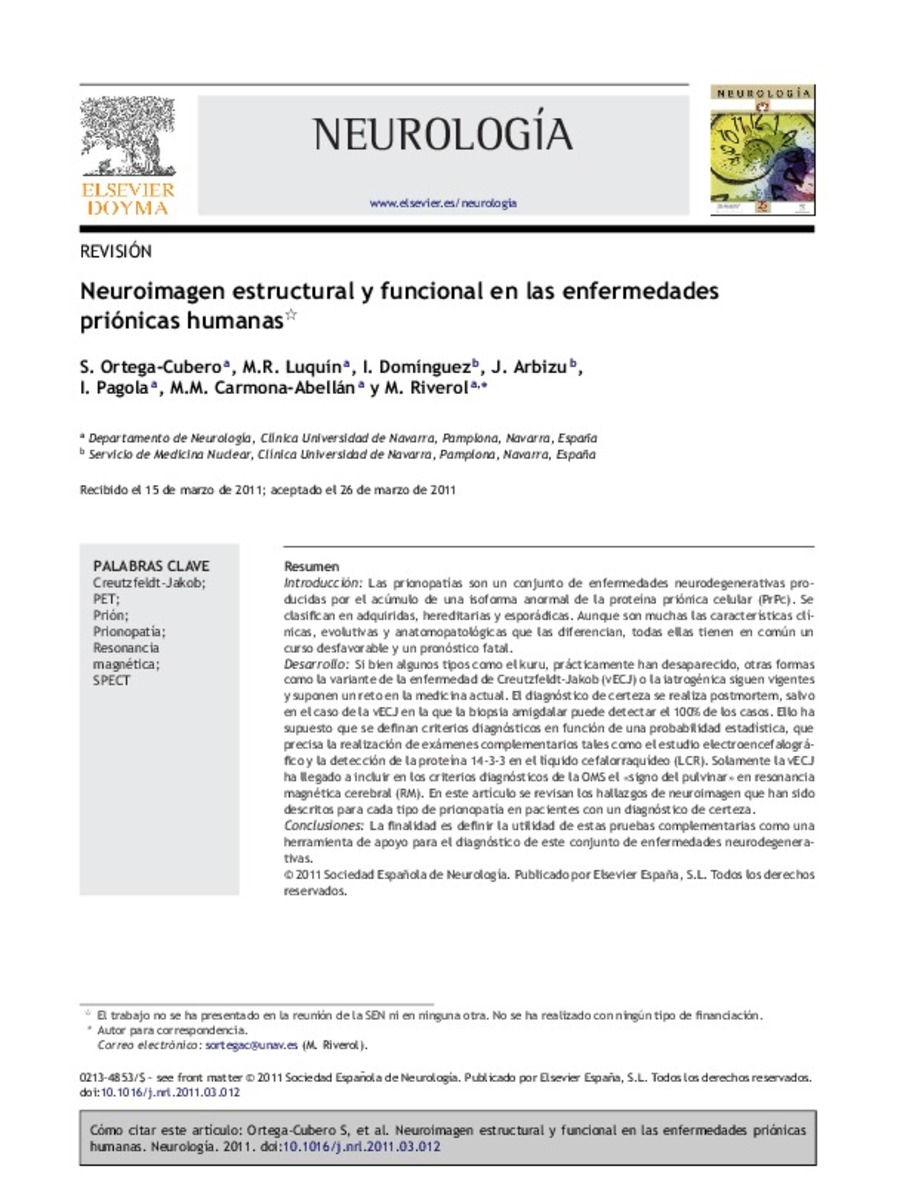Full metadata record
| DC Field | Value | Language |
|---|---|---|
| dc.creator | Riverol, M. (Mario) | - |
| dc.creator | Carmona-Abellán, M.M. (María del Mar) | - |
| dc.creator | Pagola, I. (I.) | - |
| dc.creator | Arbizu, J. (Javier) | - |
| dc.creator | Dominguez-Prado, I. (Inés) | - |
| dc.creator | Luquin, M.R. (María Rosario) | - |
| dc.creator | Ortega-Cubero, S. (Sara) | - |
| dc.date.accessioned | 2012-07-03T08:28:54Z | - |
| dc.date.available | 2012-07-03T08:28:54Z | - |
| dc.date.issued | 2011 | - |
| dc.identifier.citation | Ortega-Cubero S, Luquin MR, Dominguez I, Arbizu J, Pagola I, Carmona-Abellan MM, et al. Neuroimagen estructural y funcional en las enfermedades priónicas humanas. Neurologia 2013 Jun;28(5):299-308 | es_ES |
| dc.identifier.issn | 0213-4853 | - |
| dc.identifier.uri | https://hdl.handle.net/10171/22787 | - |
| dc.description.abstract | INTRODUCTION: Prion diseases are neurodegenerative disorders resulting from the accumulation of a misfolded isoform of the cellular prion protein (PrPc). They can occur as acquired, sporadic or hereditary forms. Although prion diseases show a wide range of phenotypic variations, pathological features and clinical evolution, they are all characterised by a common unfavourable course and a fatal outcome. REVIEW SUMMARY: Some variants, such as kuru, have practically disappeared, while others, for example the variant Creutzfeldt-Jakob (vCJD) or those attributable to iatrogenic causes, are still in force and pose a challenge to current medicine. There are no definitive pre-mortem diagnostic tests, except for vCJD, where a tonsil biopsy detects 100% of the cases. For this reason, diagnostic criteria dependent on statistical probability have had to be created. These require complementary examinations, such as an electroencephalogram (EEG) or the detection of 14-3-3 protein in cerebrospinal fluid (CSF). Only the "pulvinar sign" in magnetic resonance imaging (MRI) has been included as a vCJD diagnostic criterion. The present review discusses neuroimaging findings for each type of prion disease in patients with a definitive histopathological diagnosis. CONCLUSIONS: The aim is to define the usefulness of these complementary examinations as a tool for the diagnosis of this family of neurodegenerative diseases. | es_ES |
| dc.language.iso | spa | es_ES |
| dc.publisher | Elsevier España | es_ES |
| dc.rights | info:eu-repo/semantics/openAccess | es_ES |
| dc.subject | SPECT | es_ES |
| dc.subject | PET | es_ES |
| dc.subject | Creutzfeldt-Jakob | es_ES |
| dc.title | Neuroimagen estructural y funcional en las enfermedades priónicas humanas | es_ES |
| dc.title.alternative | Structural and functional neuroimaging in human prion diseases | - |
| dc.type | info:eu-repo/semantics/article | es_ES |
| dc.type.driver | info:eu-repo/semantics/article | es_ES |
| dc.identifier.doi | http://dx.doi.org/10.1016/j.nrleng.2011.03.012 | es_ES |
Files in This Item:
Statistics and impact
Items in Dadun are protected by copyright, with all rights reserved, unless otherwise indicated.






